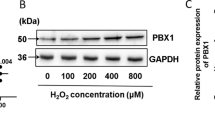Summary
To confirm the existence of heme oxygenase (HO)-carbon monoxide (CO)- cyclic guanosine monophosphate (cGMP) pathway in the cultured human trabecular meshwork cells (HTMCs)in vitro, and to evaluate the inductive role of hemin on his pathway, HTMCs of the third to fourth generation were culturedin vitro. Reverse transcipase-polymerase chain reaction (RT-PCR) was employed for detection of HO-1 and HO-2 mRNA. Immunohistochemical staining was used to detect HO-1 and HO-2 proteins. Hemin was added into the culture solution. The HO-1 mRNA levels were quantified by RT-PCR. The relative amount of carbon monoxide released into the media was measured with the quantifying carbon monoxide hemoglobin (HbCO) by spectrophotometry. Radioimmunoassay was used to determine changes of cGMP in HTMCs. The results showed that cultured cells had the specific characteristics of HTMCs. Both HO-1 and HO-2 genes were expressed in HTMCs, as well as HO-1 and HO-2 proteins in HTMCs. Hemin induced HO-1 mRNA, HbCO and cGMP in a dose-dependent manner. In conclusion, HO-CO-cGMP pathway exists in the cultured HTMCs and can be induced by hemin. Pharmacological stimulation of HO-CO-cGMP pathway may constitute a novel therapeutic approach to rescuing glaucoma.
Similar content being viewed by others
References
Wiederholt M, Sturm A, Lepple-Wienhues A. Relaxation of trabecular meshwork and ciliary muscle by release of nitric oxide. Invest Ophthalmol Vis Sci, 1994, 35(5):2515
Dulak J, Jozkowicz A. Carbon monoxide—a “new” gascous modulator of gene expression. Acta Biochim Pol. 2003, 50(1):31
Morita T, Perrella M A, Lee M Eet al. Smooth muscle cell derived carbon monoxide is a regulator of vascular cGMP. Proc Natl Acad Sci USA, 1995, 92(5):1475
Brune B, Ullrich V, Inhibition of platelet aggregation by carbon monoxide is mediated by activation of guanylate cyclase. Mol Pharmacol, 1987 32(4):497
Chen L, Zhao J H. A new celluar messenger molecule: carbon monoxide. Chin J Intern Med (Chinese), 1999, 38(4):270
Elbirt K K, Bonkovsky H L. Heme oxygenase: recent advances in understanding its regulation and role. Proc Assoc Am Physicians, 1999, 111(5):438
Kee C, Kaufman P L, Gabelt B T. Effect of 8-Br cGMP on aqueous humor dynamics in monkeys. Invest Ophthalmol Vis Sci. 1994, 35(6):2769
Brouard S, Otterbein L E, Anrather Jet al. Carbon monoxide generated by heme oxygenase 1 suppresses endothelial cell apoptosis. J Exp Med, 2000, 192 (7): 1015
Otterbein LE, Choi AM. Heme oxygenase: colors of defense against cellular stress. Am J Physiol Lung Cell Mol Physiol, 2000, 279(6):L1029
Author information
Authors and Affiliations
Additional information
LI Tao, male, born in 1976, Doctor in Charge
Rights and permissions
About this article
Cite this article
Tao, L., Hong, Z. & Feng, L. Existence of heme oxygenase-carbon monoxide-cyclic guanosine monophosphate pathway in human trabecular meshwork cellsin vitro. Current Medical Science 24, 173–177 (2004). https://doi.org/10.1007/BF02885422
Received:
Published:
Issue Date:
DOI: https://doi.org/10.1007/BF02885422




